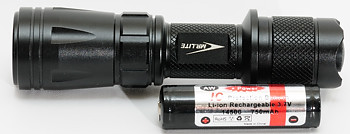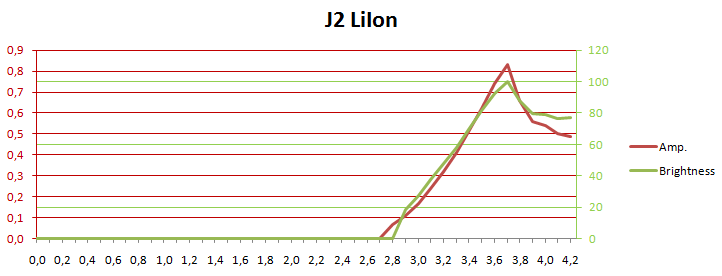Mr.Lite J2




Mr.Lite is a manufacturer with a broad selection of lights, here I am taking a look on AA light with two different drives. The light has the (manufacturer) programmable user interface and this time I asked to get a custom programming. The light always start at the same setting, presses on the switch will cycle through the different settings.
I received only the lights, no box or accessories was supplied for the review.


The light has an OP (Orange peel) reflector with a Cree XR-E led in the center.

The head of the light has no knurling, but uses a few big squares as texture. This gives a fair grip on the light.

Looking into the backside of the head shows the battery connection with a solid construction.



The body tube has a smooth knurling on it, but due to the shape of the light it cannot slide out of the hand. The treads work well and has a O-ring to make prevent water from entering here. The anodized on the tread makes it possible to lock out the light.

The threads on the battery tube are symmetric, it can be mounted either way round.

The battery tube also has some holes for mounting a clip, but the clip was not supplied for the review.

The inside of the tailcap has a spring with a cap on for connection to the battery.

The switch is a reverse switch, beneath the typical rubber boot.

Here is the complete light with all parts it can be dismantled in without tools.

The standard user interface has lots of settings.

But as I wrote at the top, this light does not use the standard UI, but instead I specified what I wanted:
- Medium 30%: General purpose usage, this setting is fine for most of lightning needs.
- As low as possible: When I want a very long runtime or just a low brightness.
- As bright as possible: Sometimes I also need as much light as possible.
- Slow strobe, around 5 Hz with 60% pwm: This strobe can be used for warning or marking purpose.
- Beacon, 0.1 second flash each 2 second at full power: For marking, has a very long runtime and can be spotted from a long distance.
I did not get exactly what I asked, but something close and I believe very useful, see the technical analysis. People that do not like the standard settings or my selection, can just order it with their own selection of modes and brightness settings.
I like the possibility to order it with a custom defined user interface on this light, getting a light with the perfect settings is a big plus. The construction of the light is solid and the driver keeps the brightness fairly stable.
Technical specification and measurements


I have tested this light with two different drivers, one for AA batteries (NiMH, Alkaline, Lithium) and one for 14500 LiIon batteries. The LiIon driver will shut down the light when the battery is empty, i.e. it can be used with unprotected batteries.
Measured size and weight:
Length: 108 mm
Diameter: 18 to 28 mm
Weight: 103.7 gram with LiIon battery, 108.5 gram with eneloop battery
The light uses a Cree XR-E led.
The standard programming on this light has 5 brightness settings and 4 flashing modes, for measurements with that kind of driver programming, see some other MrLite review (SS2, LT2, KC-05). This light has a custom programming with 3 brightness settings and 2 flashing modes.

First table is for the LiIon driver. For the brightness I used a luxmeter and then scaled the values, the pwm is measured with my oscilloscope and a light sensor, the current with my DMM on peak/average (Fluke 289). For the estimated runtime I have take the current measurements and divided into 600 (i.e. a 600 mAh battery), this is a very rough estimate.
PS: The , in the table is a decimal point.

Second table for the NiMH driver. The brightness of the medium and low level is nearly the same as for LiIon, but the high level is brighter.
For the runtime I assumed a 2000mAh battery.

Doing a voltage sweep with the LiIon driver shows that the light has a rather peculiar characteristic, it has maximum brightness at around 3.7 volt. This can also be seen in the runtime curve, the brightness will increase while the battery is drained and then start dropping.

The NiMH is more normal, more voltage will give more brightness..

Here are the runtime curves for medium and high. They have small variations, but this will not be visible in real usage.
For all the scope traces below, the LiIon will be first, followed by the NiMH


The LiIon driver has some smoothing on the output, this reduces the on spikes on low (And makes measuring pwm percents difficult). The NiMH driver has the full pwm spike.
I measured the pwm to 286 Hz for LiIon and 290 Hz for NiMH (this is probably just component tolerances).


Again the smoothing in the LiIon driver is very obvious. The NiMH driver starts at a high level and then reduces the output.


On high the LiIon driver keeps the output on all the time. The NiMH driver is running at a lower output, but the pwm is still present.


For the LiIon the strobe is 2 hz and for NiMH it is 2.8 hz, both with 50% duty cycle and both at around half power.


For the LiIon the beacon is a 0.1 second flash every 1.6 second and for NiMH it is 0.05 second flash every 1.5 second, bot at high brightness.
Comparison to other Flashlights
For beamshots and comparison to other light see here.
Notes
Two versions of the light were supplied by Mr.Lite for a review.
































